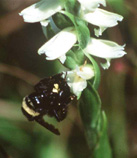Spiranthes magnicamporum Sheviak
Great plains ladies'-tresses
The specific epithet magnicamporum is the Latin meaning "of
the large plain," referring to the prairie habitat that this species
is found in.



DESCRIPTION: Plant
pubescent above the leaves, 12-38 cm tall (including inflorescence), arising
from a cluster of large, fleshy roots, appearing tuberous. Leaves
2-3, basal, oblanceolate to linear-lanceolate, 10-14 cm long and 0.8-1 cm
wide, fugacious (withering at flowering), grading into reduced sheathing
bracts below the inflorescence, the bracts typically overlapping. Inflorescence
a downy, spicate raceme of 20-40 creamy-white to yellowish, fragrant flowers,
12-38 cm tall, dense and multi-ranked, each flower subtended by an elongate,
ovate-lanceolate bract. Sepals linear-lanceolate, 6-11 mm long and
about 2 mm wide, the lateral sepals with margins inrolled, and typically
spreading slightly and ascending with the tips often recurved and nearly
meeting above the flower, dorsal sepal connivent with petals to form a hood
over the column, sepals creamy-white to yellowish-colored. Petals
linear-lanceolate to linear, 7-10 mm long and 1-2 mm wide, closely appressed
to the dorsal sepal, tips of dorsal sepal and petals reflexed slightly,
colored as sepals. Labellum ovate to obovate and strongly arcuate-recurved,
6.5-11 mm long and 4-6 mm wide, creamy-white to yellowish-colored with the
central portion typically thickened and yellowish, the central portion never
constricted, the base of the labellum with two small, incurved, pubescent
calli.
SIMILAR SPECIES: Easily confused with other species of Spiranthes,
particularly S.cernua. The spreading lateral
sepals, leafless stem at flowering and odor of S. magnicamporum separate
it from most S.cernua, which has appressed
lateral sepals, a leafy stem at anthesis and usually scentless flowers.
However, there are some races of S.cernuawhich
approach many of these aspects of S. magnicamporum. Separating these
specimens is extremely difficult, with the best character being embryony:
the seeds of S. magnicamporum are monoembryonic, whereas a large
percentage of the seeds of S.cernua are
polyembryonic. Where the two species co-occur (which is not uncommon in
southern Wisconsin), S. magnicamporum typically does not begin blooming
until after S.cernua has completed flowering,
and occupies drier microsites.
HABITAT: Typically found on dry bluff or hill prairies over limestone
or dolomite.
FLOWERING DATES: September 5-October 7.
POLLINATION: I have seen a bumblebee (Bombus nevadensis ssp.
americorum) pollinating Spiranthes magnicamporum in a prairie
in southeastern Wisconsin. After visiting a number of inflorescences, the
bee began to vigorously scratch at the pollinia on its proboscis, trying
to remove them. The bee became so involved in trying to remove the pollinia
that it fell to the ground, where it was easily captured. The specimen was
determined by Steve Krauth, and is deposited in the Insect Research Collection
at the University of Wisconsin-Madison. Apart from this observation, there
are no published accounts of pollination of S. magnicamporum.
DISCUSSION: This species was first described by Charles Sheviak in
1973. Until that point, it had masqueraded as a variety of taxa, including
Spiranthes odorata (or S. cernua var. odorata) and
S. ochroleuca (or S. cernua var. ochroleuca). Fuller
(1933) described S. cernua as "very fragrant," probably
actually referring to S. magnicamporum, which is strongly fragrant,
while S. cernua is weakly fragrant at most. I located a large, dense
population of S. magnicamporum in Walworth County by first smelling
the flowers, form a distance of about thirty feet. The odor has been described
as similar to coumarin. John T. Curtis collected S. magnicamporum
(as S. cernua in 1939) and affixed a note to the herbarium sheet
that said that the scent was like "Bull Durham tobacco, but sweeter."
WI DISTRIBUTION:  U.S. DISTRIBUTION:
U.S. DISTRIBUTION:
Go directly to Wisconsin herbarium
records.
Return to the main LIST of
the Orchids of Wisconsin.
Return to the main KEY to the Orchids of
Wisconsin.



 U.S. DISTRIBUTION:
U.S. DISTRIBUTION: